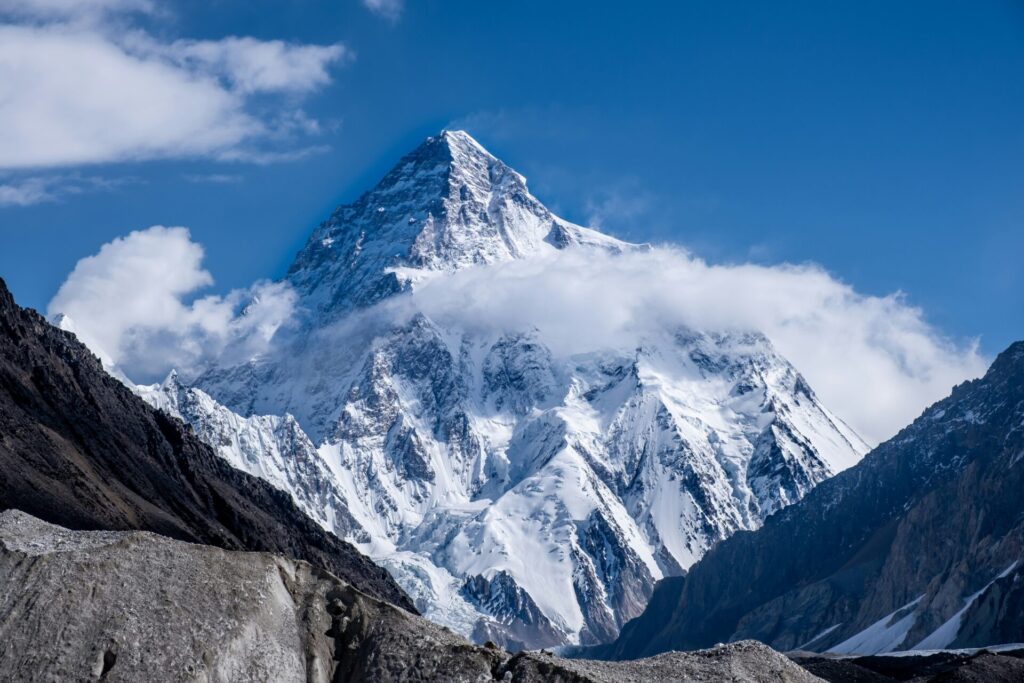Explore K2: The Savage Mountain

K2’s name alone stirs the hearts of climbers worldwide. At 8,611 meters (28,251 feet), it is the second-highest peak on Earth and is widely considered the most challenging to conquer.
Dubbed the “Savage Mountain,” K2 remains an elusive prize for mountaineers, a formidable combination of technical difficulty, exceptional weather risks, and daunting terrain.
Unlike Mount Everest, which has seen a steep rise in commercial climbing efforts over the years, K2 retains much of its savage reputation. It is the ultimate skill, endurance, and determination test for mountaineers and adventure seekers.
This blog explores why K2 is so revered, dives into the elements that make it uniquely challenging, and provides a glimpse into its profound history.
Why K2 is a Mountaineer’s Dream
The Savage Mountain
K2 has earned the moniker “Savage Mountain” for good reason. American climber George Bell cemented the nickname in 1953 when he referred to K2 as “a savage mountain that tries to kill you.”
By 2023, K2’s death-to-summit ratio stood at 11%, marking it as one of the most dangerous peaks to climb, surpassed only by Annapurna and Nanga Parbat.
Factors contributing to its reputation include unpredictable weather, relentless winds, and steep, exposed slopes. Overcrowding on K2’s technical sections, particularly in the infamous “Bottleneck” area, has also become a growing concern.
Despite advancements in mountaineering gear and expertise, the mountain’s challenges remain incomparable, making summiting K2 a dream for the elite.
Why It’s Harder Than Everest
While Everest draws thousands of climbers annually, K2 sees far fewer attempts due to its sheer difficulty:
- Technical Challenging Routes: K2’s routes, such as the popular Abruzzi Spur and the Wind Ridge, demand complex climbing skills like ascending steep rock faces and hanging ice cliffs. Portions like “House’s Chimney” and the “Black Pyramid” test even the most seasoned climbers.
- Unpredictable Weather: Much like a chess game with nature, K2 rarely offers long weather windows that are favorable for climbing. Sudden storms and winds have derailed even the best-organized summit attempts.
- Self-reliance Over Support: Unlike Everest, where many commercial climbing operators collaborate to install fixed ropes and ladders, teamwork is sparse on K2’s undeveloped routes. Climbers must often set up their own fixed lines and rely heavily on their technical ability.
For these reasons alone, K2 attracts climbers seeking the ultimate mountaineering trophy—endurance, skills, and pure grit.
K2’s Most Iconic Features
The Abruzzi Spur
The Abruzzi Spur is K2’s most popular ascent route, accounting for 75% of all summits. The route features technical highlights such as:
- House’s Chimney: A 100-foot vertical crack requiring careful crampon and rock climbing skills.
- The Bottleneck: A narrow, steep couloir located 400 meters below the summit, overshadowed by looming seracs (ice towers). The seracs have famously caused avalanches, such as the deadly 2008 tragedy.
The Bottleneck’s Legacy
One of the most notorious sections on K2, the Bottleneck symbolizes the mountain’s danger and allure.
It demands extreme caution due to its risk of ice and snow collapsing.
Climbers breaking trail through knee-deep snow while navigating this treacherous area face some of the harshest conditions in mountaineering.
The Shoulder and Beyond
Above the Bottleneck lies K2’s upper slopes, a steep and punishing climb requiring precision, teamwork, and occasionally knee-deep snow navigation. The reward? It was a breathtaking, unforgettable summit.
A Brief History of K2 Encounters
First Ascents
K2 was first summited on July 31, 1954, a triumph of Italian climbers Lino Lacedelli and Achille Compagnoni via the Abruzzi Spur.
Their ascent remains one of the significant milestones of mountaineering history, though it was not without controversy.
A disagreement among team members over the placement of oxygen supplies resulted in significant frostbite injuries for some, including Pakistani porter Amir Mehdi.
Winter Wonders
It wasn’t until 2021—67 years later—that K2 was summited in winter. Led by Nirmal “Nims” Purja and Mingma Gyalje Sherpa, a team of Nepalese climbers achieved this long-elusive goal, braving -40°F temperatures to open a new chapter for K2’s legacy.
Modern Expeditions
In recent years, advancements in gear, weather predictions, and climbing techniques have made K2 slightly more accessible. However, its inherent danger persists, and each summit attempt remains a testament to human resilience and dedication.
When to Visit K2 Base Camp
Timing your trek is important to ensure safe and enjoyable conditions.
The best months to visit K2 Base Camp are from June to August, during Pakistan’s summer trekking season. Here’s why:
- Weather: The warm summer temperatures keep the trails accessible and safer, though nights can still get extremely cold.
- Trail Conditions: Melting snow keeps trails navigable, and the risk of avalanches or bad weather is significantly lower during this period.
- Crowds: While summer is peak trekking season, the route to K2 Base Camp is still far less crowded than comparable treks like Everest Base Camp.
Preparing for the Trek
A successful trip to K2 Base Camp begins with proper preparation. This trek is no walk in the park—it’s a challenging multi-day hike that requires both physical and logistical readiness.
1. Physical Fitness and Training
The trek to K2 Base Camp involves long days of hiking, steep ascents, and rough terrain. To prepare, focus on building your endurance, strength, and cardiovascular fitness. Start training at least three months in advance with activities like:
- Long-distance hikes with a weighted backpack
- Strength training for your legs and core
- Cardiovascular exercise such as running or cycling
- Mental preparation for handling consecutive days of trekking
2. Permits and Regulations
Trekking in the Karakoram Range requires several permits, including:
- A trekking permit from Pakistani authorities
- A No Objection Certificate (NOC) for travel to certain restricted areas
- A licensed local guide to accompany you
Your tour operator will typically handle these permits, so choose a reputable agency to streamline the process.
3. Packing Essentials
Packing wisely can make or break your trek. Here’s a list of must-haves for the K2 Base Camp trek:
- Clothing:
- Layered clothing (base layer, insulating layer, waterproof layer)
- High-quality trekking boots
- Gloves, hats, and gaiters for cold and snowy conditions
- Gear:
- Trekking poles
- A sturdy 50-70L backpack
- Lightweight sleeping bag rated for sub-zero temperatures
- Other Essentials:
- High-energy snacks and electrolyte packets
- Water purification tablets
- First-aid kit and personal medications
- GPS devices and/or maps
4. Choosing a Trekking Agency
While experienced trekkers may consider going independently, most opt for guided tours to K2 Base Camp.
A good agency will provide logistical support, guides, and porters to ease your burden.
Spend time researching and reviewing operators to ensure they have a reputable history of successfully guiding groups to K2 Base Camp.
The Trekking Route
The trek to K2 Base Camp spans 13-15 days, beginning in the scenic village of Askole. Here’s a breakdown of the major stops along the way:
1. Askole to Jhula
Your trek begins in Askole, a small village that serves as the gateway to K2 Base Camp. From here, a short hike takes you to Jhula, where you’ll set up camp for the night.
2. Jhula to Paiju
The trail to Paiju leads you through rocky terrain along the Braldu River. Paiju is often considered the last stop before reaching the dramatic, icy landscapes that characterize the rest of the trek.
3. Paiju to Urdukas
This segment offers stunning views of the surrounding mountains and glaciers. Urdukas lies at a higher altitude, and trekkers often spend a rest day here to acclimatize.
4. Urdukas to Goro II
From Urdukas, the trail becomes steeper and more challenging. You’ll traverse the ice-covered Baltoro Glacier before reaching Goro II—a high-altitude campsite surrounded by towering peaks.
5. Goro II to Concordia
Known as the “Throne Room of the Mountain Gods,” Concordia is a magical place where the towering peaks of K2, Broad Peak, and Gasherbrum IV dominate the skyline.
6. Concordia to K2 Base Camp
The final leg takes you to K2 Base Camp itself. Standing at an altitude of over 5,000 meters, the base camp offers breathtaking views of the Savage Mountain. Spend some time soaking in your accomplishment before beginning the return trek.
Challenges and Tips for Success
The trek to K2 Base Camp comes with its share of challenges. Here are common hurdles and how to overcome them:
Altitude Sickness
With elevations exceeding 5,000 meters, altitude sickness is a genuine concern. Combat this by:
- Gradually acclimatizing
- Staying hydrated
- Watching for symptoms like headache or nausea and notifying your guide immediately
Weather
The Karakoram Range is known for its unpredictable weather. Carry appropriate layers and always check forecasts before setting out each day.
Endurance
Long trekking days can be taxing. Train rigorously beforehand and pace yourself to avoid burnout.
An Adventure Worth Every Step
The trek to K2 Base Camp is not just a physical challenge; it’s an emotional and spiritual journey into one of the planet’s most remote and majestic corners. From the camaraderie of fellow trekkers to the unforgettable landscapes, every step offers a reward.
If K2 Base Camp is calling your name, there’s no better time to start planning your adventure.
Lace-up your boots, pack your gear, and set out for an experience that will leave you speechless—and craving more.
